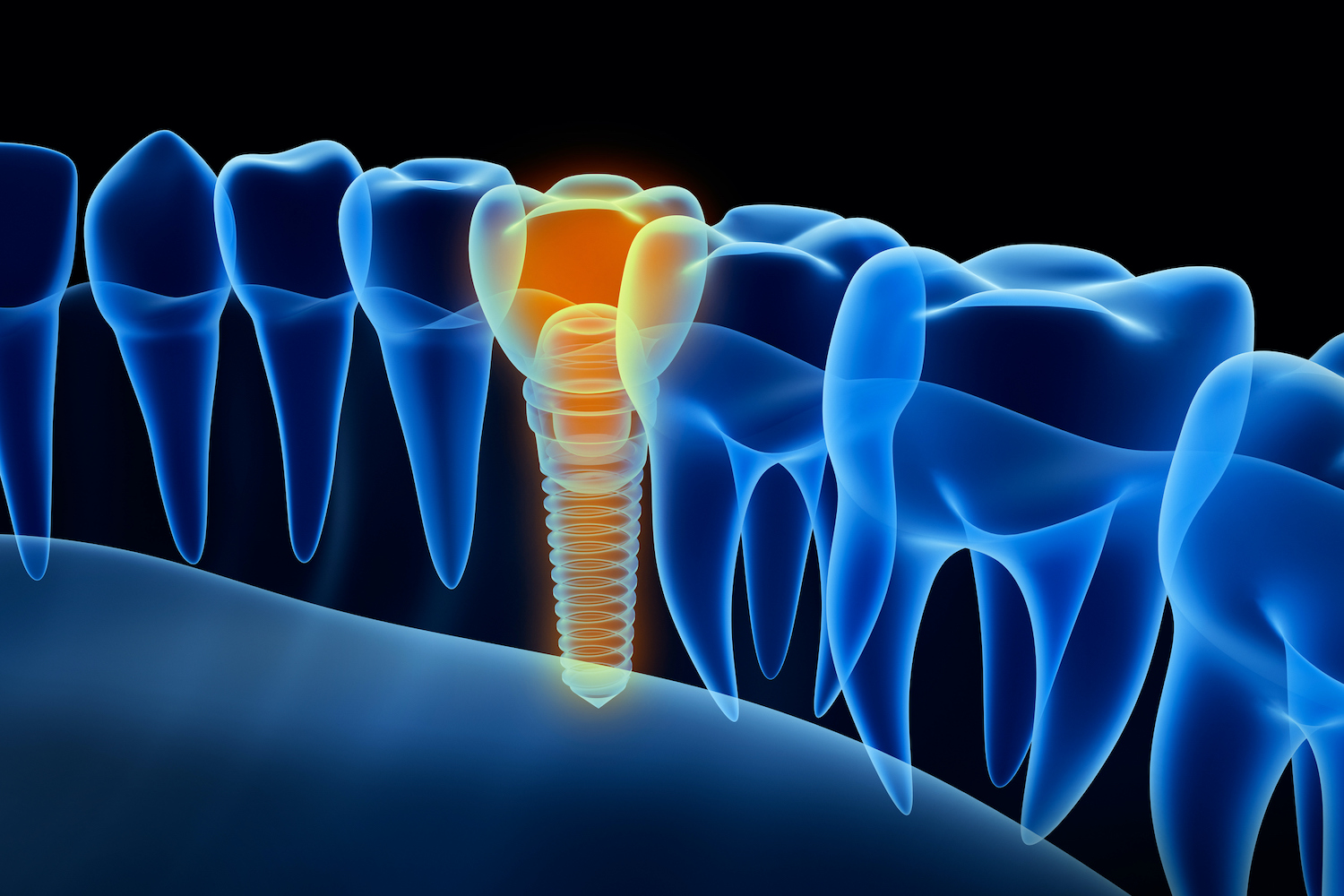Choosing the right cone-beam computed tomography (CBCT) system for your dental practice is an important decision, but it can be complicated. Dentistry’s Guide to the best CBCT systems provides a clear and comprehensive overview of the leading brands and models of CBCT scanner, helping you decide which will be most appropriate for your practice and your patients.
CBCT dental scans offer 3D images showing a patient’s teeth, gums, nerve pathways and bones, as well as other details, and are a critical tool in helping ensure the best-possible placement of dental implants. These detailed 3D CBCT images are able to reveal a patient’s bone thickness around nerve canals and sinus cavities, helping dentists assess whether additional treatments, such as bone grafts, may be required ahead of implants.
CBCT scans may also provide evidence suggesting that a patient is not suitable for dental implants. These advantages arguably make 3D CBCT scans much more useful than 2D scans. The level of detail in the images makes it more likely that any subsequent treatment will be effective, and can increase the success rates of post-endodontic restorations.
How do CBCT systems work?
CBCT systems work by using X-rays that scan a huge array of angles inside a patient’s mouth. The CBCT machine rotates around a patient’s head during the scanning to achieve these results.
The images that CBCT scans produce are ultra-precise and high-resolution, providing meticulous measurements from inside the mouth, as well as details of bone and tissue density.
As well as aiding dentists with implant placement, the 3D nature of CBCT scans means they can help reveal infections, cavitations and other abnormalities that traditional 2D scans may not uncover, and can assist with the planning of root canal treatments.
What are the main advantages of CBCT scans for dentists?
The level of detail that CBCT scans provide means that cone-beam computed tomography systems offer important advantages compared with alternatives such as orthopantomograms (OPG).
This is primarily a result of the 3D nature of the images that CBCT systems produce. OPGs provide panoramic 2D X-rays of the upper and lower jaw, but enhanced 3D X-rays of the kind that dental CBCT scans produce offer clear benefits for endodontics and orthodontics.
For endodontists, CBCT images are proving useful in revealing issues such as ‘hidden’ canals that 2D scans may be unable to expose. This is enabling them to diagnose dental problems more effectively and more efficiently, helping them produce better endodontic treatment plans for their patients.
For orthodontists, there are also clear advantages of using CBCT scans. The added benefits of 3D X-rays rather than traditional 2D images are perhaps most evident when diagnosing and deciding on the most appropriate action for dental implants and teeth movement. Having access to a clear 360-degree view of the patient’s mouth makes it far easier to understand the oral situation, find appropriate solutions and pinpoint potential problems.
How are CBCT scans better for patients?
CBCT scans also offer obvious benefits for dental patients. They are usually far faster than 2D scans, often taking around 20 minutes in total, and sometime less. The CBCT scans themselves take under a minute – and can often be completed in a matter of seconds – although time is needed beforehand to position the patient correctly. This increased speed is a result of CBCT systems capturing all the images they need during a single rotation.
Shorter scan times also make CBCT systems more comfortable for patients than older 2D OPG systems and other X-ray machines or MRI scans. These conventional dental systems often need to take numerous scans from a range of angles, requiring patients to stay still for long periods, while holding uncomfortable bite blocks between their teeth. In the case of MRI scans, the need to lie in a tunnel for up to 90 minutes may be off-putting to some patients.
CBCT scans are non-invasive and offer a painless experience for patients. Bite blocks have been softened and streamlined in many cases, to make them more comfortable.
While a higher level of radiation is involved with CBCT scans than 2D X-rays, the level is still low and is not close to that of traditional CT scans. Many CBCT systems offer an option to raise or lower radiation doses as required.
Patients should obviously be advised around the levels of radiation involved. Dentists should also note that CBCT scans are not recommended for pregnant women or those who are planning to become pregnant.
Features to consider when buying a CBCT system
Field of view (image size)
This is likely to be the leading consideration for any dentist before buying a CBCT scanner. The dimensions of the images that dental CBCT scans can produce is wide and varied. More advanced machines will generally be able to produce larger images, and operate with a larger range of image sizes. Different image sizes offer different benefits – larger, jaw-sized or full cephalometric shots work well in the diagnosis phase, while smaller, more detailed images prove more useful when planning precise implants. Many images are also able to produce 2D as well as 3D images.
Image quality
Image quality is high across the CBCT market, but some more advanced machines offer software equipped with algorithms and AI features that can clean up images in the case of patient movement. This same software can help counteract X-ray interference caused by metal dental artifacts, endodontic materials and other dental work, making it easier for a dentist to make an accurate diagnosis and suggest optimal treatment plans.
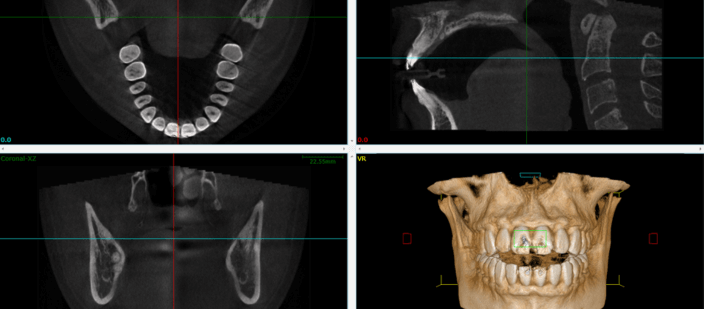
Radiation dosing
Most CBCT machines now offer low and ultra-low radiation dosing, which can be important to reassure patients and for helping dentists adhere to ‘as low as reasonably achievable’ (ALARA) principles. The length of scan time also plays a part in the level of radiation exposure, so this may be worth considering. Low dosing may have been associated with low image quality in the past, but advances in corrective algorithms, AI and patient positioning are increasingly able to compensate for this.
Patient comfort and positioning
A wide range of factors can play a part in levels of patient comfort. Machine size, scan time, bite block material and positioning are all important. Automated positioning and height-adjustable machinery can also be helpful. Would your patients prefer a machine with head supports and chin cup, or a less intrusive option? A minority of machines also feature seats, which may be helpful for dentists who tend to have older or younger patients. It is worth noting that stable patient positioning remains a critical factor in ensuring the highest possible image quality, even when CBCT machines have software and algorithms that can clean up images.
Space and installation requirements
Physical space is obviously a fundamental factor when selecting a CBCT scanner. Do you need to fit the machine into a corner of your practice, or are you able to place it in a dedicated room. Many CBCT systems have a small footprint and are designed to be elegant and unobtrusive. However, some come with the option of adding arms with cameras on either side to improve the quality of the 3D scans produced. This has obvious implications for space, as does the fact that some are wall-mounted while others are floor-mounted. This could affect installation time – another key factor that should be clarified before buying any CBCT system. Lengthy installation could lead to practice downtime and impact the ability to see patients.
Additional software and other costs
CBCT systems generally cost between £35,000 and £120,000. As well as this initial outlay, some machines may require additional spending on software, system installation and other features and upgrades. It’s worth clarifying whether this is the case before making a purchase. Also check that the CBCT system software is interoperable with any other packages your practice may use.
Customer support
It may also be worth considering the level of customer support available – can the vendor offer on-the-ground support, or only phone assistance? Some manufacturers also offer training for dentists who buy their equipment and software. This can include in-person sessions or online resources.
Brands and models of CBCT systems
Acteon Group

Acteon Group has invested significantly in cutting-edge technologies to build up a range of state-of-the-art dental products, including CBCT devices. Its advanced imaging systems offer exemplary diagnostic precision, and like all of the company’s products, are designed to meet the evolving needs of dental professionals worldwide. To book a showroom visit or speak to an Acteon representative, click here.
Innovative technology
Acteon’s imaging solutions include digital radiography, 3D imaging systems and intraoral cameras. These provide dental practitioners with the clear, detailed views they need to carry out accurate diagnoses, plan treatment and communicate effectively with patients.
The Acteon X-Mind Prime 2D or 3D CBCT device embodies the innovation that is typical of the company’s dental imaging technology. Featuring Acteon Imaging Suite (AIS) software, the unit packs a comprehensive set of features into a remarkably compact footprint – another key element of Acteon’s designs, and one that makes its products suitable for all kinds of dental practices.
The Acteon X-Mind Prime CBCT device
Acteon’s X-Mind Prime CBCT unit provides high-quality imaging without the need for a dedicated X-ray room. It is designed to offer a complete solution for dental practices, eliminating the need for additional purchases or upgrades.

The unit comes supplied as standard with all the necessary components and software, meaning that users will never encounter hidden costs or unexpected annual charges. This all-inclusive approach makes it a cost-effective choice for dental practices, simplifying budgeting and financial planning. By offering everything in one package, Acteon ensures that practices can start using the device immediately, without facing the upheaval of piecemeal installations or additional software integrations.
Versatile imaging
Versatility is a hallmark of the X-Mind Prime. The CBCT device offers a range of imaging modes, including 2D and 3D, across four fields of view – 5cm x 5cm, 8.5cm x 5cm, 8.5cm x 10cm and 12cm x 10cm. This means it is able to cater to all dental diagnostic needs.
The system’s 3D imaging provides detailed, high-resolution views, especially in the smallest field of view, which has a voxel size of 75µm resolution. This is critical for precise diagnosis and accurate treatment planning. These capabilities also make the X-Mind Prime ideal for a wide range of applications, from routine dental check-ups to complex surgical planning.
The ability to switch between different imaging modes enhances the device’s utility, making it a valuable tool for comprehensive patient care.
Compact design
An important feature of the Acteon X-Mind Prime is its compact and aesthetically appealing design. Some CBCT scanners and imaging devices can be bulky and require substantial amounts of space. Traditional CBCT devices often require a specialised room, which can be a substantial financial burden for dental practices.
This is not the case with the X-Mind Prime, whose compact design and efficient operation mean that even practices with limited space can benefit from its advanced imaging capabilities, without losing any of the typical functionality of larger machines. This flexibility also allows practices to maximise their existing space without incurring additional construction or renovation costs.
Easy to install and use
Having a CBCT device that is simple to install and use should be a core consideration for dental practices. The X-Mind Prime is designed with this simplicity in mind. Its installation process is straightforward and swift, meaning it can be operational in a short space of time. This sets it apart from many other complex imaging systems, which require extensive set-up and calibration. The quick installation time also minimises practice downtime and disruption, allowing dentists to continue serving patients without lengthy interruptions.
Once installation is complete, the simple face-to-face patient positioning and the user-friendly interface of its AIS software ensures that dental professionals can quickly become experts in operating the device.
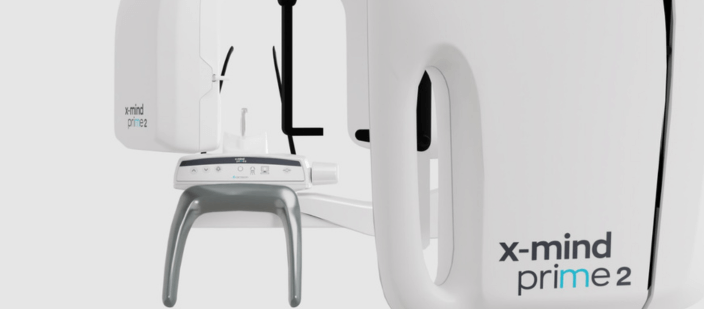
Intuitive software
AIS software is highly intuitive, guiding users through every step of the imaging process. Designed to streamline the dental imaging process, it features a simple, easy-to-navigate interface that ensures efficient scanning and workflows, allowing the dentist to dedicate more time to the patient.
The software integrates seamlessly with the X-Mind Prime and other Acteon imaging devices. It enables advanced image processing and analysis, as well as reporting and storage capabilities. Users can also import an intraoral STL scan from any brand of intraoral scanner, or scan a traditional impression with the CBCT device to create surgical guides.
This ease of use extends to patient management – the X-Mind Prime quickly captures detailed images, ensuring minimal discomfort for patients, and allowing more time for communication and discussions of any treatment plan that may be required. A patient report can also be created in minutes, allowing the patient to take away a detailed treatment plan containing all the information they need to know about their case.
Clear cost structure
Clarity around costs is a key consideration for any dental practice investing in a CBCT device. Will there be additional investment needed for software, installation or other services?
Acteon has structured its pricing for the X-Mind Prime to be completely transparent. It includes all the necessary components and software, meaning dental practices will not face hidden fees and annual charges that can become a burden. This transparency allows practices to plan their finances with confidence, knowing that their investment in the X-Mind Prime is both predictable and manageable.
A comprehensive solution
Acteon has designed the X-Mind Prime to be more than simply an imaging device – it is a comprehensive CBCT solution that addresses the diverse needs of modern dental practices. Its combination of advanced technology, user-friendly software and financial transparency position it as a leading choice for a wide range of dental professionals seeking to enhance their diagnostic and treatment capabilities.
Client support is also provided by Acteon. It offers extensive training and support for dental professionals who use its equipment and software, with a range of workshops, seminars and online resources ensuring clients are kept up to date on the latest technologies and techniques.
The company has a strong international presence and a clear commitment to customer service. With clients in more than 100 countries, a robust global distribution network and a reputation as a leader in dental innovation, Aceton is trusted by dentists, oral surgeons and hygienists around the world.
Sustainability and corporate responsibility are also a priority for Acteon, with the company actively seeking to minimise its environmental footprint through sustainable manufacturing practices and eco-friendly product designs.
Want to know more about Acteon’s CBCT devices?
Click the button below to book a showroom visit or speak to an Acteon representative.
Carestream Dental

Carestream Dental aims to simplify cutting-edge technology in order to transform the dentistry profession. Headquartered in Atlanta, Georgia, its areas of focus including supplying cloud-based technology solutions for dental practices.
CS 8100 3D Evo Edition
This is the most simplified CBCT scanner in the Carestream range. It provides high-resolution, 75-micron 3D and 2D images, and uses a special algorithm to makes scans as clear as possible.
Best suited to general dentists and endodontists, it has an award-winning compact design and can slot into even small spaces. The system’s laser-free, face-to-face positioning helps ensure patients are placed optimally for a successful scan. Scans take 3-10 seconds and are then displayed on a single interface using Carestream’s CS Imaging software.
As well as offering low-dose radiation imaging, an option to resize the field of view helps limit patient exposure.
CS 8200 3D Neo Edition
Carestream’s CS 8200 3D Neo Edition offers the broadest range of fields of view for a CBCT scanner in this category. It provides full control of the imaging area up to 12cm x 10cm and down to 4cm x 4cm. Extending the field of view enables single scans to capture the patient’s full arch, including third molars. This more advanced CBCT system also offers the option to reduce radiation dosing by up to 50{e60f258f32f4d0090826105a8a8e4487cca35cebb3251bd7e4de0ff6f7e40497} when in panoramic mode.
Recommended for endodontists, the CS 8200 uses CS MAR (Metal Artifact Reduction) technology to reduce image interference caused by fillings, implants or dental restorations, making it easier for dentists to provide accurate diagnoses. Like the CS 8100 Evo Edition, it completes scans in 3-10 seconds.
CS 9600 CBCT Scanner
This 5-in-1 scanner bills itself as the world’s most intelligent CBCT system. The winner of a Cellerant Best of Class Technology Award in 2023, it is currently the only CBCT scanner with a retractable seat. Combined with its AI-powered positioning system, this ensures scans are consistently of the highest possible quality. Offering an unprecedented 14 fields of view from 4cm x 4cm up to 16cm x 17cm, the CS 9600 is suitable for everything from routine examinations to specialised diagnostics. Software imaging includes the pioneering CS Face Scan, which can layer dental scans over 3D facial images, and offers implant, orthodontic, restoration and airway analysis.
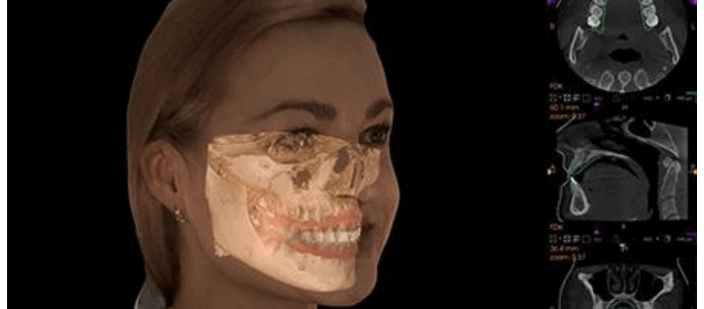
Dentsply Sirona

US-headquartered Dentsply Sirona invests more than $125 million a year in advancing its dentistry technology and innovation. It works with practices, clinics and dental laboratories around the world, and has over 4,000 staff providing customer service.
Axeos CBCT machine
Enhanced image quality is one of the standout features of Dentsply Sirona’s Axeos CBCT machine. Its ‘direct conversion sensor’ turns X-rays into electrical signals, eradicating any interference or imaging loss that might happen with traditional light-based scanners. This boosts contrast and sharpness and, when combined with the Axeos autofocus, makes panoramic radiographs as clear as possible.

There is an option to add a cephalometric arm to further improve panoramic image quality. The arm – which can be fitted on either side of the machine – has a sensor that can capture and create lateral and symmetrical posterior-to-anterior or anterior-to-posterior images.
Image sizing ranges from 5cm x 5.5cm to 17cm x 13cm, with numerous options in between. This means dentists can choose to examine precise areas in detail, or opt for wider shots that provide a complete dentition overview.
Comfort for patients
The Axeos CBCT Scanner comes with a handheld EasyPad to make patient placement painless and precise. It works with an automatic positioning system and a smart height adjustment set-up that adapts to each person that uses the machine
Radiation is at a low dose level, helping put patients at ease. The unit features a minimalist bite block design with hand grips beneath for comfort and stability, and with images captured in one single, quick rotation of the machine, the entire process is unintrusive for patients.
Dexis
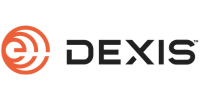
Dexis has been in business for over 200 years and has more than 150,000 clients globally. All Dexis products are designed to be interoperable and easy to integrate, so any practices that already have Dexis equipment may want to stick with the brand for their CBCT scanners.
OP 3D Vision range
Dexis offers three CBCT scanners in its OP 3D Vision range – the V8, V10 and V17, with the numbers corresponding to their fields of vision.
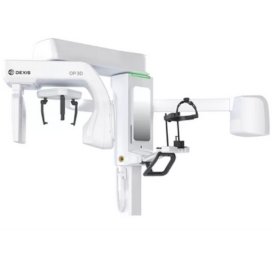
The V8 ranges from 8cm x 5cm to 8cm x 8cm, making it best suited for endodontics and for dentists working on specific areas for implants and surgery.
The V10 expands the range to 16cm x 10cm, which Dexis says is useful for practitioners working on airway and temporomandibular joint analysis, periodontics, paediatrics, or simply on larger dental cases.
The V17 reaches to an extensive 23cm x 17cm, providing clear advantages for orthodontists, oral radiologists and practitioners carrying out oral maxillofacial surgery.
Seat included
Few CBCT machines include seats, but all of those in the OP 3D Vision range do. Coupled with a special ‘ergonomic stability system’ to minimise patient movement while maximising comfort and ease of positioning, this rare feature can reduce the need for image rescans, helping keep radiation exposure to a minimum. Scan times vary from 4.8 seconds to 26.9 seconds.
Enhanced low-dose imaging options are included with all OP 3D Vision units, along with the option for traditional 2D panoramic images that can help dentists maintain ALARA principles. The 2D images are created using the same high-quality sensor as the 3D shots.
Software
All of the OP 3D Vision CBCT scanners use Tx STUDIO powered by Anatomage. This system’s treatment planning software helps dentists identify issues once scans have been completed. This could include cysts, tumours, lesions and changes of the jaw, and can help avert potential complications when surgery takes place.
The software also provides precise positioning data, allowing dentists to plan full treatment courses and implant placements, and to ensure that nerve canals, sinus walls and cortical borders can be located and avoided during interventions.
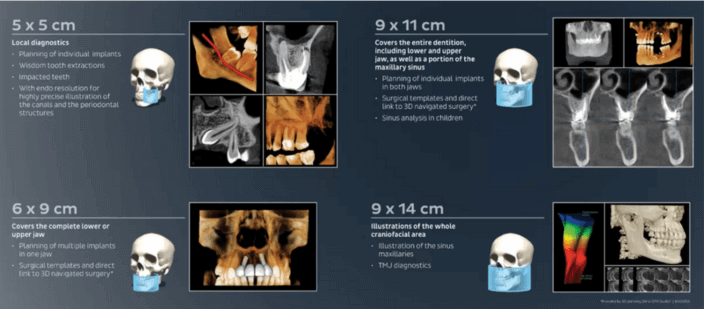
Dürr Dental
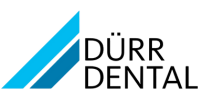
Founded in Germany in 1941, Dürr Dental has built up a customer base in nearly every corner of the world, with clients in 174 countries. To ensure maximum quality standards, it makes all of its own parts rather than importing them from other countries, as detailed in Dentistry’s feature on Dürr’s Stuttgart headquarters.
VistaVox S and VistaVox S Ceph
The VistaVox CBCT scanners from Dürr are so sleek and streamlined they have a hint of the space-age about them. The VistaVox S Ceph adds to this with its three distinctive, minimalist blue braces that position patients for cephalometric scans.
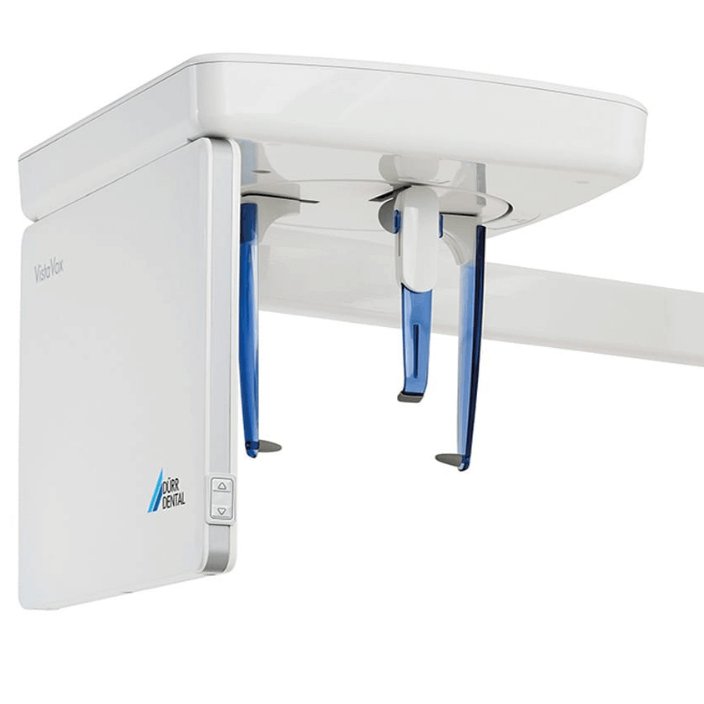
Patient comfort is optimised thanks to an especially wide and soft bite block. Named the Comfort Bite, it is designed to help reduce movement and to be particularly suitable for edentulous patients.
Jaw-shaped images
The VistaVox S offers a special jaw-shaped field of view spanning 13cm. This is larger than the most common 8cm x 8cm range, allowing the rear molars to be captured.
An additional 10 image shapes are accessible where more precise diagnosis is required, such as with endodontic treatments or implants. Five of the options cover the lower jaw while the other five cover the upper jaw.
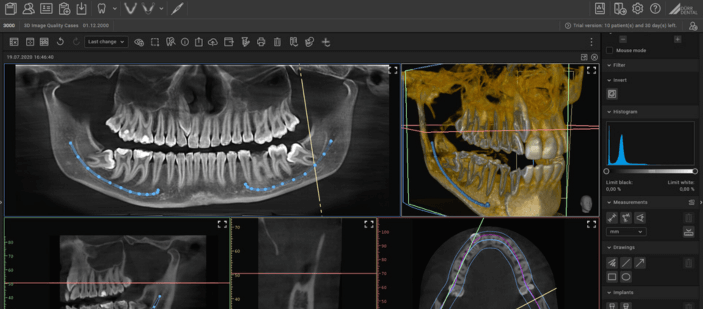
The VistaVox S creates images at 49.5 voxels while the VistaVox S Ceph ranges from 49.5 to 100 voxels.
Scan time
Scan time is among the shortest on the market at 1.9 seconds, depending on the options selected. Paired with highly sensitive CsI sensors, this ensures ultra-high image quality with minimal interference. It also keeps radiation doses low.
Planmeca

Finnish firm Planmeca has clients in over 120 countries and offers a wide range of healthcare technologies. It has put a particular focus on developing advanced imaging software, and aims to create products that are not just easy to use, but which are long-lasting and have aesthetic appeal.
Planmeca Viso range
Viso is the flagship range of Planmeca CBCT imaging units. It comprises the Viso G3, G5 and G7, each of which offers a progressively larger imaging size. The G3 can produce anything from 3cm x 3cm to 20cm x 10 cm, rising to 20cm x 17cm for the G5 and 30cm x 30cm for the G7.
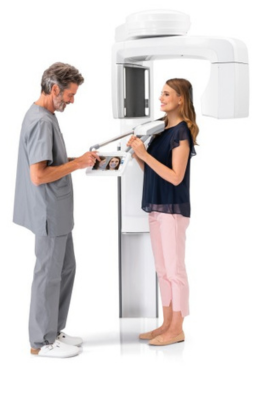
Each CBCT scanner in Planmeca’s Viso range offers 2D and 3D imaging. An intuitive control panel fitted with cameras simplifies patient positioning and image sizing, while the G5 and G7 offer less intrusive head supports that do not wrap around the patient’s ears. Patients can also opt not to use the chin cup, as a Planmeca algorithm can correct images if slight movements take place.
Radiation dosing is ultra-low, as with all Planmeca CBCT machines, while the ability to take scans of impressions or plaster casts will prove appealing for some patients, as it can remove the need for an intraoral scanner.
Planmeca ProMax 3D Classic
Superior, clinical image quality is one of the main advantages of the Planmeca ProMax 3D Classic compared with the Viso range. Views of the mandible and maxilla are notably clearer. Orthodontists will find this useful when planning brace placement.
Switching to endodontic mode captures minute details in extremely high resolution, making it effective for exacting diagnostics and treatment planning. Planmeca’s patented SCARA imaging technology uses a robotic arm to control the exact camera movements needed to capture high-quality rotational maxillofacial imaging. Image sizing reaches up to 11cm x 8cm with a single scan, but goes higher with multiple scans.
Planmeca ProMax 3D Mid
Dentists needing to carry out 3D orthodontics and ear, nose and throat (ENT) imaging will find the ProMax 3D Mid to be the most suitable Planmeca machine. As well as offering many of the same features as the ProMax 3D Classic, it goes further by providing a wider range of imaging options. ProMax 3D Mid images can reach up to 20cm x 17cm when using multiple scans, or 20xm x 10cm with a single scan.
Vatech

UK-based Vatech designs and produces all the essential parts for its dental imaging systems itself, including the software. Its seven-strong range of CBCT scanners meets a range a different dental needs and budgets, and includes 10-year warranties.
Smart X
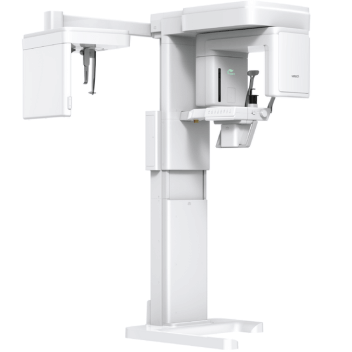
In the middle of the Vatech range is the Smart X model, which is billed as offering premium precision at a highly competitive price point.
Its field of vision options encompass 4cm × 4cm to 12cm × 8.5cm, plus the possibility of 12cm × 14cm by merging two scans. This means the Smart X can capture anything from a single tooth to the full arch.
The Smart X’s Endo Mode is designed for endodontics. It operates at 50 voxels and creates ultra-clear close-ups at high levels of focus.
Larger images are more suitable for orthodontists, and Vatech’s Smart Focus Mode enables five high-resolution images to be captured in a single, super-fast scan.
Green range
Vatech’s Green range of scanners specialise in producing high image quality with low radiation doses. There have been preconceptions in the past that lower levels of radiation automatically lead to reduced image quality, but Vatech has been working to overturn this.
Its Green 16 and 18 models merge image processing steps to produce clinical scan quality even at low radiation doses. It does this with just a 4.9-second scan time for CBCT images.
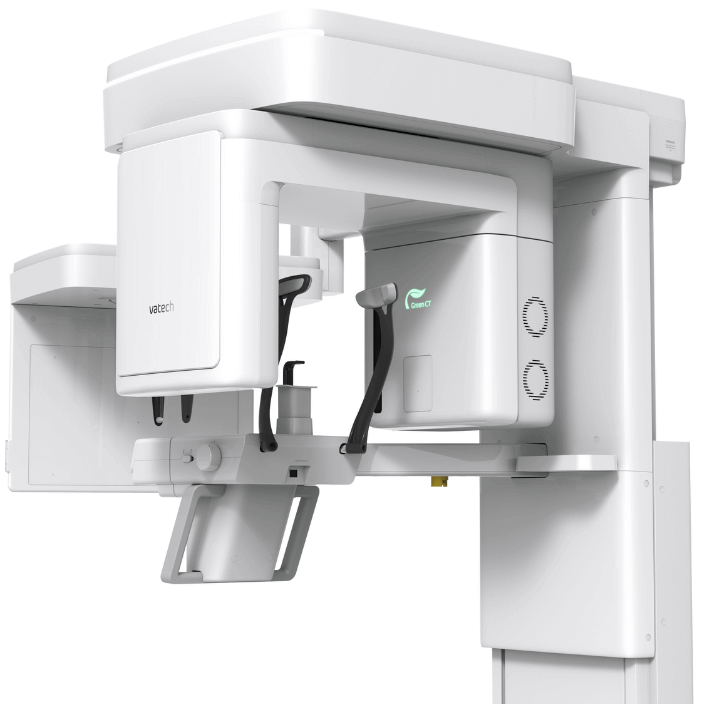
The accompanying VistaSoft 3D software provides a wide range of views to improve diagnosis. Options include transversal layer images and multiplanar reconstruction. VistaVox units include an unlimited network licence for VistaSoft, as well as a floating licence for an additional three 3D workstations.
Dos and don’ts to consider before buying a CBCT system
A CBCT system is a long-term investment. The cost can be high – exceeding £100,000 in some cases – and the amount of consideration that goes into selecting a machine should be just as high. Taking time to make the best decision is important, as it is one that any dental practice likely to have to live with for many years. Getting the correct CBCT machine is also critical for dentists’ professional endeavours, as well as for their patients.
Here is our round-up of some of the dos and don’ts to think about before committing to a CBCT scanner.
- DO consider field of view How wide or how tight and detailed your CBCT scan can go is one of the leading considerations when buying a machine. Orthodontists and endodontists will have different needs.
- DO consider image quality CBCT scanners tend to provide high-resolution images, but if you have specific needs for high levels of minute detail, make sure you look at voxel size. Also ask about algorithms and AI that can improve image quality.
- DO consider the CBCT system’s physical footprint Practicality matters – do you need a CBCT unit that can fit in a corner of your practice, or do you have a dedicated room where it can go?
- DO look at radiation settings Many CBCT systems offer low and ultra-low doses. Do you need settings that can be changed? Or is it ok if the dose is standardised?
- DO think about your patients Would a seat be useful for your patients? What about softer bite blocks or hand grips? And how important is the speed of the scan?
- DON’T overlook software Is the software included in the price? How easy is it to use, and is training provided? Does it offer advanced algorithms or AI to correct and clean up images? It is interoperable with other software you use?
- DON’T forget to ask about additional costs As well as software, find out whether installation, servicing, warranty and training courses are included or come at an extra cost.
- DON’T miss trade shows These vital opportunities to view CBCT machines in person can help provide a clear idea on whether a system is the right one for you and your practice.
- DON’T forget to think about financing options Withsome CBCT scanners costing over £100,000, finding out about financing options may be a wise decision.
Frequently asked questions
When considering which CBCT system might be right for your practice, here are some common questions to consider:
The cost of a CBCT scanner varies significantly, with a broad range of £35,000 to £120,000, depending on image sizing, software capabilities, speed of scan and other features.
Many CBCT systems are designed to have as small a physical footprint as possible. They tend to be at least 1.2 metres wide and deep. Their height typically ranges from 1.5 metres to 2.3 metres. The space needed will increase if cephalometric arms are added. Bear in mind the fact that the machine has to rotate when it carries out scans.
CBCT systems usually offer 3D and 2D scans. Field of view typically starts at 4cm x 4cm and many machines offer options rising through 12cm x 10cm and 20cm x 17cm. Some go higher still, with the cost of the machine usually dictating the range available.
Many scans take under 10 seconds, although time is also needed to ensure the patient is positioned comfortably and correctly. This means the whole process can take up to 20 minutes. This is still much quicker than for traditional 2D scans, as CBCT systems can take all the images required during a single scan.
Most CBCT systems expose patients to only low and ultra-low doses of radiation. Dosage is higher than with less-detailed 2D X-rays, but it is not close to that of traditional CT scans. Many CBCT systems offer an option to raise or lower radiation doses as required. Specification should be checked when buying a CBCT scanner.
Summary
CBCT scans are an increasingly central part of modern dentistry. The advance to 3D from 2D images, complemented by ultra-high resolution imagery, is advancing accuracy in diagnosis and success levels in structuring treatment plans, whether for disease treatment, dental implants or more extensive surgery.
Deciding on which is the best CBCT system for your practice will depend on a number of factors, from the kind of dental services you offer (orthodontic, endodontics, maxillofacial surgery) to the physical space you have available and the amount you are prepared to spend.
This guide provides an overview of the different types of CBCT machines available, and some of the key considerations dentists need to make before committing to a purchase.
By taking the time to develop an understanding of the full range of options and specifications that CBCT scanners offer, dentists can ensure they buy the right machine not just for their practice, but for their patients. We hope this guide to CBCT systems – along with the many other articles about CBCT on the Dentistry website – prove a valuable resource to help you on your buying journey.





